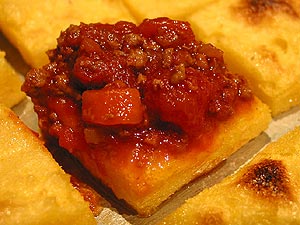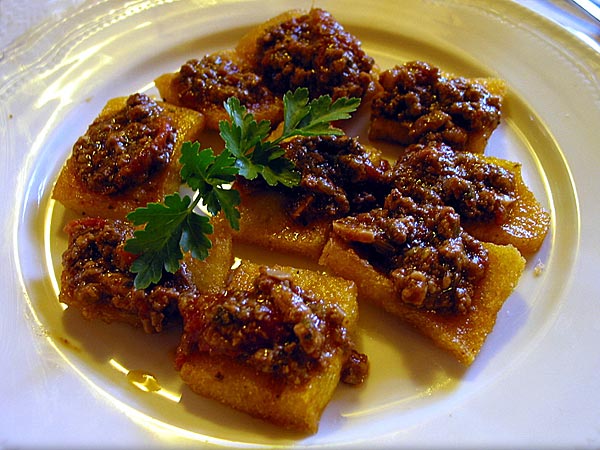Polenta
Makes 24 pieces
4½ cups water
1 tsp salt
1½ cup medium-grind Italian polenta or cornmeal
Pour the water into
a large heavy saucepan and bring it to a boil. Add the salt, lower the
heat to medium, gradually add the polenta by sprinkling it into the water
from your hand, stirring the mixture constantly with a long-handled wooden
spoon. Take care, and be patient as you add the polenta or it will be
lumpy.
Continue to cook and stir the mixture constantly; if a lump does appear,
try to crush it against the side of the pot. After about 15 - 20 minutes
the polenta will be quite thick and will form large bubbles. The mixture
is done when it begins to pull away from the side of the pot as you stir.
If you are preparing a dish that calls for firm polenta, such as the Polenta Crostini, pour the mixture onto a large wooden board or work surface, baking sheet, or flat platter. Smooth the polenta with a wet spatula or your dampened hands, and shape it into a rectangle to ½ inch thickness. The polenta will cool fairly rapidly and become firm enough to cut in 10 to 15 minutes. Cut into 1¾ x 1¾ inch pieces. It can be made hours in advance and kept covered in the refrigerator.
Preheat the broiler. Place the polenta pieces on an oiled baking sheet and put under the broiler for 3 to 5 minutes, turn until both sides are a rich golden color but do not let them brown. This can be done ahead of dinner and covered with plastic wrap. Bring pieces to room temperature before assembling. For assembly, spoon heated ragù (see recipe below) onto polenta crostini. Garnish with Italian parsley and serve.
Topping variations: anchovy fillets, pitted olives, freshly grated cheese, chopped tomatoes, thick tomato sauce, or pesto.
Ragù
- Meat Sauce, Bolognese Style
Makes: 2¼ to 2½ cups
 2
Tbl chopped yellow onion
2
Tbl chopped yellow onion
3 Tbl olive oil
3 Tbl butter
2 Tbl chopped celery
2 Tbl chopped carrot
¾ lb ground lean beef, preferably chuck
1 cup red wine
28 oz can plum tomatoes roughly chopped, with juice
1. An earthenware pot should be your first choice for making ragù. If you don't have one available, use a heavy, enameled cast-iron casserole, the deepest one you have (to keep the ragù from reducing too quickly). Put in the chopped onion, with all the oil and butter, and saute briefly over medium heat until just translucent. Add the celery and carrot and cook gently for 2 minutes.
2. Add the ground beef, crumbling it in the pot with a fork. Add 1 tsp salt, stir, and cook only until the meat has lost its raw, red color. Add the wine, turn the heat up to medium high, and cook, stirring occasionally, until all the wine has evaporated.
3. Turn the heat down to medium. Add the tomatoes and stir thoroughly. When the tomatoes have started to bubble, turn the heat down until the sauce cooks at the laziest simmer, just an occasional bubble. Cook, uncovered, for a minimum of 1½ to 2 hours, stirring occasionally. Taste and correct for salt.
NOTE: Ragù can be kept in the refrigerator for up to 5 days, or frozen. Reheat until it simmers for about 15 minutes before using. If too thick, add 1-2 Tbls. Water.
